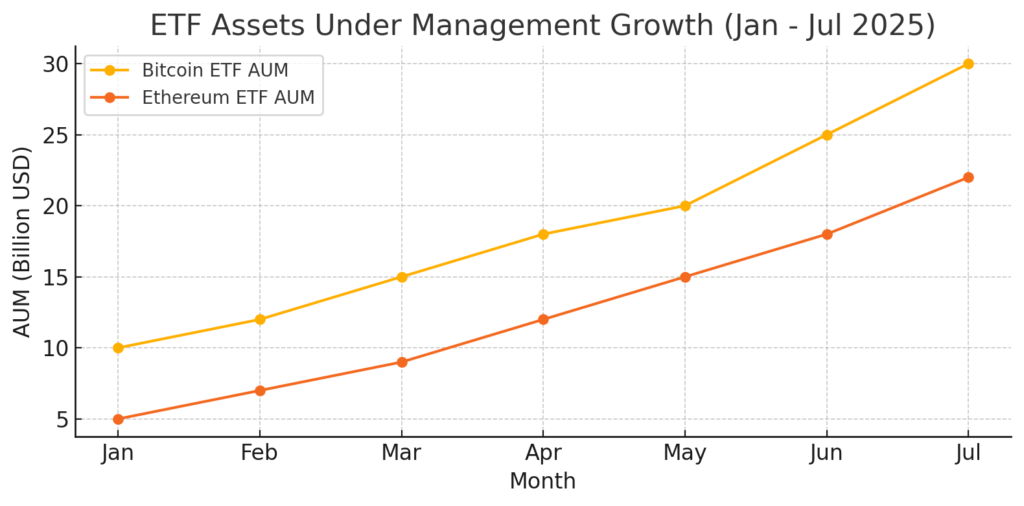
Key Takeaways:
- The U.S. Securities and Exchange Commission (SEC) has approved in‑kind (physical) creation and redemption for all spot Bitcoin (BTC) and Ethereum (ETH) ETFs, aligning them with traditional commodity ETFs and cutting costs for institutional investors.
- Under new Chair Paul Atkins, this marks the first major crypto‑friendly policy pivot, reflecting a more open regulatory stance toward digital assets.
- Authorized participants can now directly exchange BTC or ETH for ETF shares, eliminating cash‑only processes and enhancing arbitrage and hedging efficiency.
- BlackRock’s iShares Bitcoin Trust (IBIT), along with other issuers like Fidelity and Ark Invest, is poised to benefit most, having petitioned for this change earlier in the year.
- The move is expected to unlock significant institutional flows, as evidenced by $11.2 billion in combined July inflows across BTC and ETH ETFs.
- International comparison: Hong Kong’s SFC allowed in‑kind redemptions years ago, and U.S. adoption may drive global convergence.
- Figure 1 (below) illustrates the explosive growth in ETF assets under management (AUM) from January to July 2025—proof of mounting institutional demand.
1. Regulatory U‑Turn Under Chair Paul Atkins
On July 29–30, 2025, the SEC announced that all spot Bitcoin and Ethereum ETFs may henceforth utilize in‑kind creations and redemptions—meaning authorized participants can deliver the actual cryptocurrencies rather than cash when issuing or redeeming ETF shares. This decision is the first significant crypto‑friendly policy move under Paul Atkins, who was sworn in as SEC Chair earlier this year and has championed a balanced, innovation‑friendly regulatory framework. By permitting in‑kind transactions, the SEC brings crypto ETPs in line with commodity ETFs (like gold), where physical shipments are standard and cost‑effective.
2. Mechanics of In‑Kind Creation and Redemption
Traditionally, U.S. spot Bitcoin ETFs, approved in January 2024, permitted only cash‑based redemptions, forcing institutions to sell BTC in the open market to meet redemption requests—adding friction and market impact. With in‑kind authorization, an authorized participant can now hand over, say, 10 BTC to the ETF custodian in exchange for ETF shares or vice versa—eliminating the need for USD conversions and tightening the ETF’s tracking error. This model enables real‑time supply adjustments to investor demand, reducing operational complexity and lowering counterparty risk.
3. Institutional Benefits and Market Efficiency
The new in‑kind mechanism is expected to supercharge arbitrage and hedging strategies. Financial institutions, recognized as “authorized participants,” can seamlessly arbitrage price discrepancies between spot and ETF markets without triggering cash transactions. Moreover, the SEC simultaneously raised IBIT’s options position limits—allowing larger hedged positions and fostering deeper liquidity in derivatives markets. As a result, we anticipate a marked increase in institutional participation, mirroring trends seen in other developed markets.
4. Winners: BlackRock, Fidelity, Ark Invest, and Beyond
BlackRock’s iShares Bitcoin Trust (IBIT) led the charge by filing for in‑kind transactions in January 2025, followed closely by Fidelity’s Wise Origin Bitcoin Fund and Ark Invest’s spot Ether ETF proposals. These issuers stand to benefit most immediately, as their infrastructures are already configured for physical transfers. Retail investors may not feel a direct impact, but institutional efficiency gains often trickle down through tighter spreads and improved tracking performance.
5. Global Context: Learning from Hong Kong
Hong Kong’s Securities and Futures Commission (SFC) implemented in‑kind redemptions for crypto ETFs back in 2021, contributing to a highly liquid and mature ETF ecosystem in Asia. The U.S. decision narrows the gap and could encourage other jurisdictions—such as the EU under MiCA—to adopt similar measures. However, tracking net flows in an in‑kind world poses new challenges, as physical BTC or ETH deliveries do not generate cash inflows, complicating sentiment analysis.
6. July 2025 ETF Inflows and AUM Explosion
Institutional confidence is already evident: BTC and ETH ETFs saw combined inflows of $11.2 billion in July alone, with spot Bitcoin funds attracting $7.9 billion and Ether ETFs $3.3 billion.
Figure 1. ETF Assets Under Management Growth (Jan – Jul 2025)

7. Practical Implications for Crypto Investors
- Lower Expense Ratios: In‑kind redemptions typically reduce fund operational costs, which may translate into lower fees over time.
- Enhanced Price Discovery: Direct deliveries tighten the basis between spot and ETF markets, improving price transparency.
- Risk Mitigation: Eliminating cash conversion exposure reduces counterparty and settlement risks.
- Hedging Opportunities: Expanded options capacity for IBIT opens the door to sophisticated risk‑management strategies.
Conclusion
The SEC’s approval of in‑kind creation and redemption for all spot Bitcoin and Ethereum ETFs represents a watershed moment for institutional crypto adoption in the U.S. By aligning digital‐asset ETPs with traditional commodity frameworks, the SEC under Paul Atkins has signaled a more pragmatic and innovation‐friendly regulatory approach. As authorized participants leverage physical transactions to optimize arbitrage, hedging, and liquidity, investors—both institutional and retail—stand to benefit from lower costs, tighter spreads, and improved market efficiency. With global peers like Hong Kong already reaping these advantages, U.S. adoption is poised to accelerate mainstream integration of crypto into diversified portfolios.

